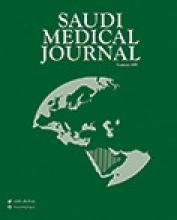Abstract
OBJECTIVE: To examine the clinical pattern of pediatric ulcerative colitis (UC) at King Abdul-Aziz University Hospital, Jeddah, Saudi Arabia.
METHODS: In this retrospective study, we collected data from the medical and endoscopy records of pediatric ulcerative colitis patients between January 2001 and March 2010. The study took place in the Department of Pediatrics, Faculty of Medicine and King Abdul-Aziz University Hospital, King Abdul-Aziz University, Jeddah, Kingdom of Saudi Arabia.
RESULTS: Fifty-seven patients were investigated with mean age±SD at diagnosis of 8.8±4.9 years. The study population comprised of 54 (59.6%) females and 42 (73.7%) males. The most common symptoms identified were abdominal pain (93%), rectal bleeding (93%), and diarrhea (86%). The extra-intestinal manifestations were observed in some patients (7%), and 2 (3.5%) had family history of first-degree relatives with inflammatory bowel disease (IBD). The anatomical extent of UC was severe in 77.2%, left sided in 12.3%, and distal in 10.5%. The endoscopic assessment of mucosal inflammation was graded as moderate to severe. The disease pattern included chronic relapse type (50.9%), initial onset type (40.4%), and chronic continuous type with intermittent exacerbation (8.8%). Laboratory results demonstrated the following symptoms such as anemia (86%), thrombocytosis (74.4%), hypoalbuminemia (54.4%), high erythrocyte sedimentation rate (83%) and high Creactive protein (77.8%).
CONCLUSION: The incidence of UC in the western region of Saudi was found to be similar with reports from the Western population. Pediatricians should be conscious of such manifestations with early referral to specialized centers in order to avoid unnecessary delay in diagnosis and complications.
- Copyright: © Saudi Medical Journal
This is an open-access article distributed under the terms of the Creative Commons Attribution-Noncommercial License (CC BY-NC), which permits unrestricted use, distribution, and reproduction in any medium, provided the original work is properly cited.






